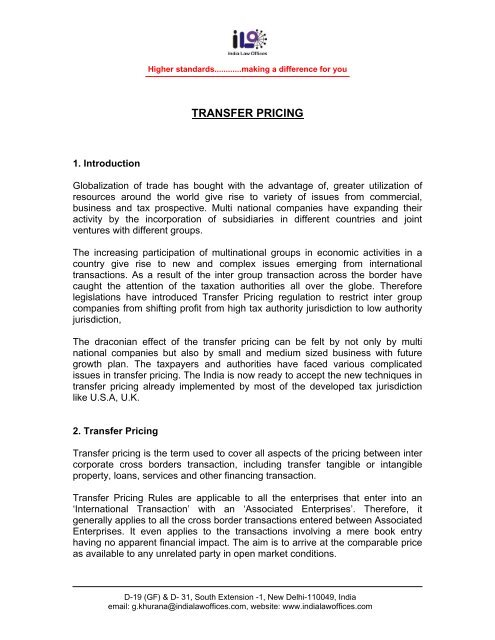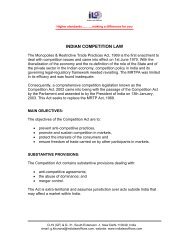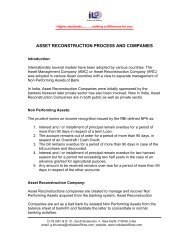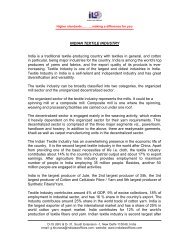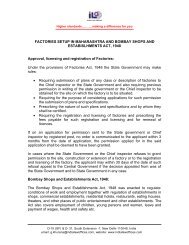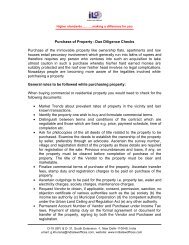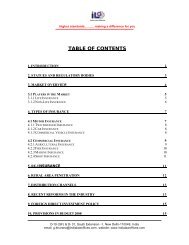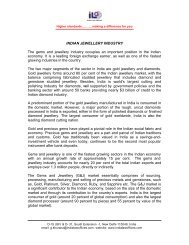Transfer Pricing - India Law Offices
Transfer Pricing - India Law Offices
Transfer Pricing - India Law Offices
Create successful ePaper yourself
Turn your PDF publications into a flip-book with our unique Google optimized e-Paper software.
Higher standards............making a difference for you<br />
TRANSFER PRICING<br />
1. Introduction<br />
Globalization of trade has bought with the advantage of, greater utilization of<br />
resources around the world give rise to variety of issues from commercial,<br />
business and tax prospective. Multi national companies have expanding their<br />
activity by the incorporation of subsidiaries in different countries and joint<br />
ventures with different groups.<br />
The increasing participation of multinational groups in economic activities in a<br />
country give rise to new and complex issues emerging from international<br />
transactions. As a result of the inter group transaction across the border have<br />
caught the attention of the taxation authorities all over the globe. Therefore<br />
legislations have introduced <strong>Transfer</strong> <strong>Pricing</strong> regulation to restrict inter group<br />
companies from shifting profit from high tax authority jurisdiction to low authority<br />
jurisdiction,<br />
The draconian effect of the transfer pricing can be felt by not only by multi<br />
national companies but also by small and medium sized business with future<br />
growth plan. The taxpayers and authorities have faced various complicated<br />
issues in transfer pricing. The <strong>India</strong> is now ready to accept the new techniques in<br />
transfer pricing already implemented by most of the developed tax jurisdiction<br />
like U.S.A, U.K.<br />
2. <strong>Transfer</strong> <strong>Pricing</strong><br />
<strong>Transfer</strong> pricing is the term used to cover all aspects of the pricing between inter<br />
corporate cross borders transaction, including transfer tangible or intangible<br />
property, loans, services and other financing transaction.<br />
<strong>Transfer</strong> <strong>Pricing</strong> Rules are applicable to all the enterprises that enter into an<br />
‘International Transaction’ with an ‘Associated Enterprises’. Therefore, it<br />
generally applies to all the cross border transactions entered between Associated<br />
Enterprises. It even applies to the transactions involving a mere book entry<br />
having no apparent financial impact. The aim is to arrive at the comparable price<br />
as available to any unrelated party in open market conditions.<br />
D-19 (GF) & D- 31, South Extension -1, New Delhi-110049, <strong>India</strong><br />
email: g.khurana@indialawoffices.com, website: www.indialawoffices.com
Higher standards............making a difference for you<br />
Many countries as a consequence of the globalization, felt that multi national<br />
companies makes an arrangement in such a way that they earn more profit in<br />
low tax jurisdiction. This is achieved by shifting cost or apportionment of cost or<br />
expense or under invoicing or over invoicing or other innovative plans. To stop<br />
these practices, the Article 9 of the OECD model convention gives the right to<br />
make transfer pricing adjustment by a country in income or cost related to<br />
international transaction.<br />
The Government of <strong>India</strong> also enacted laws effective from Financial Year 2001-<br />
2002 by which rules have been framed to determine income arising from an<br />
international transaction or the cost of transaction between associated<br />
enterprises to computed having regard to Arm Length Price<br />
2.1 International Transaction<br />
An international transaction is essentially a cross border transaction with<br />
Associated Enterprises in any sort of property, whether tangible or intangible, or<br />
in the provision of services, lending of the money etc. At least one of the party to<br />
the transaction must be a non resident entering into one of the following<br />
transaction:<br />
• Purchase, sale or lease of tangible or intangible property<br />
• Provision of services<br />
• Lending or borrowing of money<br />
• Any other transaction having a bearing on the profits, income, losses or<br />
asset<br />
• Mutual cost sharing agreement<br />
2.2 Associated Enterprises (AE)<br />
The basic criteria to determine an AE is the participation in management, control<br />
or capital (ownership) of one enterprise by another enterprise. The participation<br />
may be direct or indirect or through one or more intermediaries.<br />
The concept of the control adopted in the legislation extends not only to control<br />
through holding shares or voting power or power to appoint the management of<br />
the enterprise but also through debt, relatives and control over the various<br />
component of the business actively performed by taxpayer such as control over<br />
raw material, sales and intangible.<br />
D-19 (GF) & D- 31, South Extension -1, New Delhi-110049, <strong>India</strong><br />
email: g.khurana@indialawoffices.com, website: www.indialawoffices.com
Higher standards............making a difference for you<br />
2.3 Arm Length Principle<br />
A deal between two inter- related or associate enterprises. That is behavior as if<br />
they were not related, so that there is no query of disagreement of attention. In<br />
simple way we can describe as, “a deal between two unconnected enterprise or<br />
uncontrolled price”.<br />
The ‘arm length principle’ of transfer pricing states that the amount charge by one<br />
related party to other must be same as if the party is not related. An arm length<br />
price of that transaction would be uncontrolled price.<br />
3. <strong>India</strong>n Tax authorities<br />
Internationally accepted method of transfer pricing like Arm Length Price,<br />
statistical tools and Advance <strong>Pricing</strong> agreement (APA) and applicability of range<br />
vis a vis an arithmetic means are some illustrative development. The increasing<br />
number of litigation and high administrative cost has cause the Central Board of<br />
Direct Tax to suggest the implementation of these methods<br />
The <strong>India</strong>n Income Tax authority usually show aggressive stand on transfer<br />
pricing. Such strict approach of the income tax authority may restrict multinational<br />
companies from entering into the business in <strong>India</strong>.<br />
But recently, the income tax authority proposed the measures like Safe Harbour,<br />
Alternative Dispute Resolution in the budget that would reduce the hardship on<br />
taxpayer of going current appellate process, reduce litigations, reducing<br />
administrative cost and bring certainty in transfer pricing issues.<br />
4. Computation of Arm Length Price<br />
The most important aspect of the transfer pricing is the computing Arm Length<br />
Price in a cross border transactions. The price that would charge by one related<br />
party to another must be same as if it had been entered into by unrelated party in<br />
similar conditions. The Arm’s Length Price shall be determined by the methods<br />
specified in Income tax provisions.<br />
Five methods have been prescribed to determine Arm Length Price:<br />
• Comparable uncontrolled price method<br />
D-19 (GF) & D- 31, South Extension -1, New Delhi-110049, <strong>India</strong><br />
email: g.khurana@indialawoffices.com, website: www.indialawoffices.com
Higher standards............making a difference for you<br />
• Resale price method<br />
• Cost plus method<br />
• Profit split method<br />
• Transactional net margin method<br />
• Such other method as may be prescribed by Board<br />
The taxpayer can select the most appropriate method to be applied to any given<br />
transaction, but such selection has to be made on taking into the account factors<br />
prescribed in the law. The rules have laid down a detailed set of procedures for<br />
computing the Arm Length Price in each of the methods. The rules also<br />
prescribed the various factors to be considered in determining appropriate<br />
method, the documents are to be made and the format of the report.<br />
When one or more price is determined by the most appropriate method, the Arm<br />
Length Price shall be taken to be the arithmetic mean of such prices. However, if<br />
the arithmetic mean of such prices is with in the band of 5% of the transfer<br />
pricing then arithmetic means shall be considered as Arm Length Price.<br />
5. Burden of proof on Tax Payer<br />
The primary responsibility is on the taxpayer to determine Arm Length Price in<br />
accordance with the <strong>Transfer</strong> <strong>Pricing</strong> Regulation. Where such data used for<br />
determining the Arm Length Price is reliable and correct there can be no<br />
intervention by the tax officer.<br />
In the following cases, tax officer may reject the Arm Length Price:<br />
• price charged in international transaction has not been determined in<br />
accordance with the method prescribed,<br />
• or information and documents relating to international transaction have not<br />
been kept and maintained by the assessee in accordance with <strong>Transfer</strong><br />
<strong>Pricing</strong> Regulation,<br />
• or information or data used in the computation of the Arm Length Price is<br />
not reliable,<br />
• or assessee has failed to furnish any information or document which he<br />
was required to under <strong>Transfer</strong> <strong>Pricing</strong> Regulation<br />
For this purpose, he would then refer the matter to the <strong>Transfer</strong> <strong>Pricing</strong> Officer<br />
who would determine the Arm Length Price after hearing the argument of the<br />
assessee.<br />
D-19 (GF) & D- 31, South Extension -1, New Delhi-110049, <strong>India</strong><br />
email: g.khurana@indialawoffices.com, website: www.indialawoffices.com
Higher standards............making a difference for you<br />
6. Appeals / Remedies available to Taxpayer<br />
Normally, the taxpayer facing the transfer pricing adjustment is required to go<br />
through a normal appeal process to the Commissioner of Income Tax and then to<br />
the tribunal and further to courts.<br />
6.1 Alternative Dispute Resolution<br />
Recently, the budget has proposes the Alternative Dispute Resolution applicable<br />
from 1 st October, 2009.<br />
• Eligible Taxpayer<br />
a) Foreign Companies<br />
b) Person having transfer pricing variation<br />
Any taxpayer aggrieved by a proposed transfer pricing adjustment, and any<br />
foreign company can file objections to the proposed adjustment before dispute<br />
resolution panel with in 30 days of the Draft order being provided by the<br />
Assessing Officer to the Assessee.<br />
The panel will issue directions for confirming, reducing or enhancing the<br />
adjustment proposed by the revenue authorities with in 9 months of the Draft<br />
order being provided by the Assessing Officer to the Assessee.<br />
The panel’s directions are binding on the revenue authorities. The taxpayer has a<br />
further option to appeal before a tribunal in case of an adverse direction from the<br />
panel.<br />
6.2 Mutual Agreement Procedure<br />
Mutual Agreement Procedure (MAP) is a mechanism to resolve disputes<br />
regardless of the remedies available in domestic law. The MAP provisions are<br />
covered in the Double Taxation Avoidance Agreement that <strong>India</strong> has with various<br />
countries.<br />
Broad Categories of the Disputes covered in MAP:<br />
D-19 (GF) & D- 31, South Extension -1, New Delhi-110049, <strong>India</strong><br />
email: g.khurana@indialawoffices.com, website: www.indialawoffices.com
Higher standards............making a difference for you<br />
• Specific Case Provisions – Specific cases of the taxation not in<br />
accordance with Double Taxation Avoidance Agreement<br />
• General Provisions - Interpretation of the terms in the treaty<br />
• Elimination of double taxation not provided in DTAA<br />
The <strong>Transfer</strong> <strong>Pricing</strong> is expected to be a common ground for disputes under<br />
MAP. The companies are hesitating to take the benefit of MAP due to some<br />
inherent limitation. The MAP process is time consuming.<br />
7. Safe harbour<br />
The arm length price shall be determined subject to Safe harbour rules. The<br />
Board has empowered to formulate Safe harbour rules, that is, to determine the<br />
circumstances in which revenue authority will accept the transfer price declared<br />
by the taxpayer.<br />
Safe harbour rules will help to achieve the objective of compliance relief,<br />
administrative simplicity. While the parameter and scope of the Safe harbour will<br />
be determined by the board with in a few months.<br />
The basic problem which is faced by companies in <strong>India</strong> is finding comparable<br />
data for documentation as required by <strong>India</strong>n regulation. The lack of acceptable<br />
data restricts companies to comply the transfer pricing requirements effectively.<br />
Therefore, in the absence of the transaction information of third party, the<br />
comparison between the transaction of the third party and taxpayer is next to<br />
impossible as it is mandate in <strong>India</strong>n law.<br />
The <strong>India</strong>n transfer pricing regime has the advantage of learning with the<br />
experience of other tax jurisdiction, which have more than two decades of<br />
experience and to incorporate similar provision in <strong>India</strong> Tax <strong>Law</strong> enable the<br />
country to attain new heights of competence in the high competitive global<br />
platform.<br />
D-19 (GF) & D- 31, South Extension -1, New Delhi-110049, <strong>India</strong><br />
email: g.khurana@indialawoffices.com, website: www.indialawoffices.com


